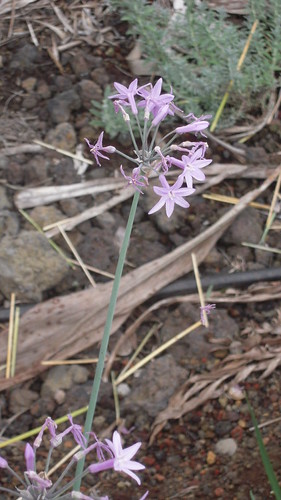
Two of my favorite landscapers (Bob and Monty) invited a group of us “tree huggers” to come tour their garden. Since the land on their property is much like that of Ocean View, I gathered lots of how-to ideas on what to grow and what not to grow.
Their elevation is about the same as mine (2300 feet), same rocky lava ground, with perhaps a little more rainfall than I receive, although everyone is experiencing the drought now. Even without much rain this year, my first impression of their acreage was very tropical, what mainlanders picture as being “Hawai`i.”
Since I have said this post is about gardening from A to Z, I suppose I’d better start with A. The rest of the alphabet will be mixed up, however, and maybe I’ll end up at Z!
I love these large deep blue Agapanthus, shown here in front of Stromanthe. The Agapanthus in my garden is smaller and more of a baby blue.

The guys have concentrated their efforts on saving the native Hawai`ian trees, like this tall ‘Ohe Makai by their gate. Like many of the Hawai`ian natives, this particular tree is on the endangered list.

A couple of other native plants they have growing are the Ulei or Hawaiian Rose . . .

. . . and the Hala Pepe.

According to Wikipedia, there are seven native Hawaiian hibiscus species. The striking native white hibiscus is one of those.

Monty’s primary interest seems to be the palms. Soft paths through the palms were everywhere.

I lost track of how many varieties of palms we saw. It seemed like we walked for miles through palm groves.

What rests below the top layer of rocks is one of the factors we all deal with here. If the drainage is stopped by a solid layer of lava, plants don’t grow well. Of those palms planted at the same time, some are quite tall, and others look like they have never grown, due to this layer that hinders root growth.

This Fishtail Palm could be one of the largest of its kind. They are rapid growers and intimidate all the other palms.

No tropical garden is complete without its anthurium plants. . .

. . . or ginger . . .

. . . or banana. This particular banana is not common. (Dare I say it’s “rare”?) It puts out two stalks of bananas each time. If you look closely, you can see them. Even the keiki (babies) that come up after the mama plant has died have the double growth.

Bob tells the story of them going to a nursery in Pahoa to buy a rhododendron, and came home with 39 of them! He said to place the plant on top of the lava, then mound cinder around it. The roots will go down between the big rocks and the small feeder roots will spread out into the cinder. I’m going to try (just) one, I think.

Spots of color were scattered throughout the acreage.

Tucked here and there were other familiar plants, such as donkey tail, ti plants, butterfly bush, and stromanthe.

We saw a few familiar plants in a variety that weren’t as typical as what we have in our own gardens, like this tri-colored jade and variegated monstera.

There were several healthy specimens of staghorn fern.

Various protea are usually found in our tropical gardens, like these banksia (not in bloom at this time), king and pincushion proteas shown here.

For me, one of the most stunning flowers was the passion flower, not the same as the lilikoi we normally have growing.

It seems everyone is suffering from either drought, effects of vog, or critters like rats, sheep, pigs, caliche pheasants. A few veggies are still producing here.

I particularly loved the delicate little “society garlic.” I was given a few small bulbs to bring home and plant. The flower can be tossed into a salad and the flavor is heavenly. My car probably still smells like garlic (not an unpleasant odor for me)!

Bob said his primary passion is xeriscaping, which is designed to reduce the amount of water generally needed for growth. That means succulents and other drought-resistant plants. I have some of these in my own garden, and I plan to do more.

At the entryway to their home are these lovely cycads, both male and female. Need I point out which is which? It’s the biggest one, of course. (smile)

I started this post with A=Agapanthus. Even though this bromeliad is called “tiger-striped bromeliad, I’ll pretend it’s a Z=Zebra-striped bromeliad to keep with the alphabet theme. (Don’t tell on me!)

A touch of serenity concludes the tour.

Enjoy this slideshow for more pictures than I could include in this post, and for individual shots of those plants I’ve made into a collage.
Click here to view the slideshow. If it takes you to a web page instead of the slide show, click on “slideshow” in the upper left hand corner.
A hui hou!


















































